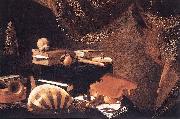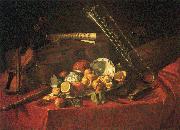
Oil On
Canvas, Real Flavor of Old Masters
|
BASCHENIS, Evaristo
|
|||
|
|
|||
| Italian Baroque Era Painter, 1617-1677 Evaristo Baschenis (December 7, 1617 ?C March 16, 1677) was an Italian Baroque painter of the 17th century, active mainly around his native city of Bergamo. He was born to a family of artists. He is best known for still lifes, most commonly of musical instruments. This could explain his friendship with a family with notable violin makers from Cremona. Still-life depictiona were uncommon as a thematic among Italian painters prior to the 17th century. Baschenis, along with the more eccentric 16th century painter Milanese Arcimboldo, represents provincial outputs with idiosyncratic tendencies that appear to appeal to the discernment of forms and shapes rather than grand manner themes of religious or mythologic events. For Arcimboldo, the artifice is everything; for Baschenis, the items, man-made musical instruments, have a purpose and a beauty even in their silent geometry. One source for his photographic style of still life could be Caravaggio's early painting of peaches, or alternatively, Dutch paintings. The most faithful imitator of his style is a younger contemporary Bergamese, Bartolomeo Bettera. Baschenis is a contemporary of the Bergamese portrait artist, Carlo Ceresa, and appears to have been influential for the Modenese artist Cristoforo Munari. | |||
|
|
|||
|
|
Still-Life with Musical Instruments BASCHENIS, Evaristo2.jpg Painting ID:: 4954 Visit European Gallery |
c. 1650 Oil on canvas, 97 x 147 cm Pinacoteca di Brera, Milan | |
Height Width |
INS/CM |
||
|
X |
|
||
|
|
|||
|
Cristoforo Munari
|
|||
|
|
|||
| (July 21, 1667 - June 3, 1720) was an Italian painter of the late-Baroque specializing in still life paintings. He was also known as Cristofano Monari. His initial training was in Reggio Emilia, his birthplace, and he came under the patronage of Rinaldo d'Este, Duke of Modena. In 1703-1706, he lived in Rome, then moved to Florence, where for about a decade he was attached to the court of the Medici. His still life paintings recall those of Evaristo Baschenis; however, the added disarray of porcelain, glass, and foodstuffs, suggest the hangover from the jovial surfeit of the Medici court. He painted also panoplies and war trophies. In 1715 he moved to Pisa where he worked almost exclusively in art restoration; he died in 1720. An exhibition of his paintings took place in 1998 in Reggio Emilia, where it attracted wide attention and was a national success. | |||
|
|
|||
|
|
Still-Life with Musical Instruments new24/Cristoforo Munari-644568.gif Painting ID:: 74681 Visit European Gallery |
1706-15 Oil on canvas | |
Height Width |
INS/CM |
||
|
X |
|
||
|
|
|||
|
unknow artist
|
|||
|
|
|||
|
|
|||
|
|
Still-Life with Musical Instruments new24/unknow artist-435438.jpg Painting ID:: 77151 Visit European Gallery |
1623 Oil on canvas 69 x 122 cm cjr | |
Height Width |
INS/CM |
||
|
X |
|
||
|
|
|||









